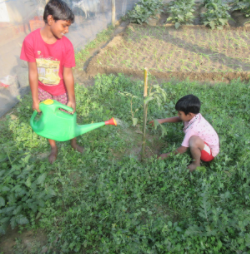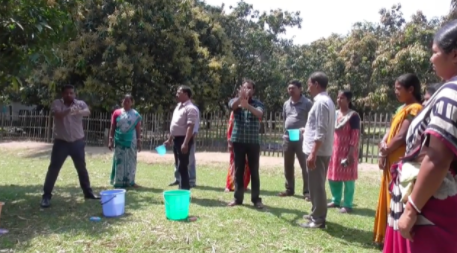Children of the Green Earth
Children of the Green Earth takes root in India
From our hearts, with our hands, for the Earth, all the world together.
Rajadighi Community Health Service Society (RCHSS), West Bengal, India
In the arid northeast corner of India, seeds planted in the early 1980s with a vision of “the earth made green again,” have blossomed into a wide-ranging program of community development aimed at creating a small-scale model of global sustainability. As a young high school teacher, Shibesh Das realized the impoverished land and people needed more than standard education. Inspired by Children of the Green Earth, he enlisted students from 40 villages, mobilizing the people in an ambitious tree planting program.
Increasing impacts of climate change – rising temperatures, drought and flooding, soil degradation and groundwater depletion – have made life even harder for people who rely on subsistence farming. RCHSS is responding with a variety of innovative programs to empower women and their diverse communities and reclaim the life forces of the earth. All programs rely on local people to identify issues, make decisions and work cooperatively to find solutions.
Children of the Green Earth
Planting Trees
Beginning with the first students’ tree planting initiative, Shibesh Das began an information exchange with Children of the Green Earth and other international organizations, ensuring a steady influx of new ideas. The first notable outcome of this information exchange was the formation of the Sukumar Program. Named for the acclaimed Bengali poet and storyteller, Sukumar Roy, the Sukumar program focused on reforestation through the creation of small woodlands throughout 40 villages. Over the course of this program, hundreds of thousands of fruit and timber trees were planted, and slowly the area became lush and green. On July 29, 1986, the Shalbona Forest gathering was held to develop future agricultural and environmental strategies. In attendance were local farmers and tribal women, as well as students from both the local schools and the city of Malda. Today, over 1 million trees have been planted through RCHSS environmental programs. The current focus is on creating nurseries containing local food varieties, such as papaya, guava, mango, and ben fruit, to address the nutrition deficiency prevalent in the villages.




Adapting Farming Practices To Changing Climate
The RCHSS program has extreme priority to address the consequences of climate change in the area. The RCHSS team and communities believe that instead of giving up completely, the program should support communities to experiment using the resources we do have. Every family has limited resources, but with a little thought they can make a huge difference. In the face of more frequent extreme weather events that are shifting temperatures and rainfall patterns, we know that continuing use of existing crops and agricultural practices will not be enough. Instead, transformative approaches will be necessary to ensure that crop and vegetable production remains viable.
Responding To The Pandemic
From the beginning of the pandemic, RCHSS has taken steps to protect community people from exposure to, and infection with COVID-19. The first step was to reach out to teach people the basic principles of hand washing and physical distancing. RCHSS published and circulated widely hand wash practice video in different languages.



